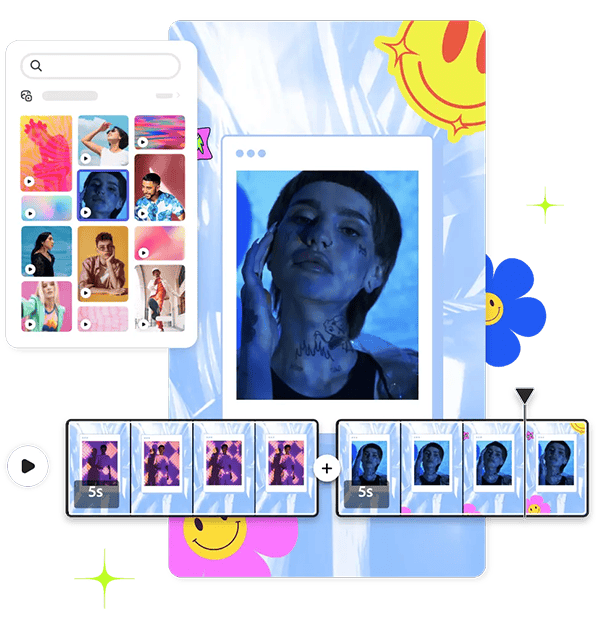Higher education faculty and leaders have noticed a concerning trend: After spending the pandemic years in learning environments that were less accommodating to creative, unstructured, or hands-on learning experiences, many of today's college students are arriving on campus with a hyper-focus on checklists and grades.
In our latest Adobe Express + Firefly webinar, Indiana University Professor Justin Hodgson shared ways that educators can build more meaningful, engaging, and failure-friendly learning experiences by integrating digital fluency into the classroom.
Replacing the “checklist mentality” with the joy of discovery
As director of IU’s Digital Gardener Institute, Hodgson leads a system-wide effort to improve digital literacy, digital creativity, and digital learning across the institution’s seven campuses and regional centers. He kicked off the webinar by sharing his experience of the “checklist mentality” that he’s seeing in today’s students.
“They have this idea that if you just itemize what they need to get done and you tell them how to do it and they do it exactly the way you tell them, then they're supposed to be successful and move on,” he said. But that approach, according to Hodgson, doesn’t invite meaningful learning, critical engagement, or creative application of concepts or ideas.
As a result, Hodgson and his Digital Gardener colleagues have been working to reimagine the classroom experience and drive student engagement. They’re using digital creativity tools like Adobe Express and Firefly generative AI in higher education classrooms to emphasize innovation, play, and even failure. Ultimately, their goal is to help students get immersed in their course material, achieve their learning outcomes, and build essential career skills.
To help students get started with a new tool like Adobe Express, Hodgson encourages three kinds of productive failure:
- Fast failure, in which students play around and turn their ideas into as many creations as they can without worrying about the quality of the work.
- Fun failure, in which students learn to relax and discover the joy of “happy embarrassment” in their mistakes.
- Formative failure, in which Hodgson gives students feedback on their final work so they can learn and grow.
Next, Hodgson teaches students the technical skills they need to create class presentations in Adobe Express by giving them what he calls “a low-stakes, high-impact” assignment. Students create and enhance images of themselves and combine them with text in simple “About me” web pages. By their third class meeting, the students are all comfortable creating in Adobe Express.
“It's not enough to say students have mastery of course content,” he said. “If they're not actively prepared to communicate and represent their thinking across media and across modalities or technologies, they are at a distinct disadvantage entering into what is clearly a post-digital culture.”
The power of transferrable creative skills
Next, Hodgson invited Amogh Busnur, an undergraduate cognitive science student, to share his experience of learning to use creative Adobe tools.
Busnur said he chose Hodgson’s Digital Literacy and Composition course because he wanted to go beyond communicating through the written word. “We were expressing these same personal narratives, but through digital means, and picking up novel skills that I thought would be very important in today's day and age,” he said.
He quickly progressed from creating images and web pages in Adobe Express to designing sophisticated research posters in Adobe InDesign to making high-quality videos in Adobe Premiere Pro.
“The only reason that this transition in progress was possible was because, in the course, we were oriented early on with creative visual communication, how to combine text and images to portray our own narratives,” he said. “Having picked up all of these digital skills in Professor Hodgson's class, they became transferable to every single class henceforth.”
In addition to creating layouts and videos that make his research and ideas stand out, Busnur is using his new skills in his side gig as a college admissions consultant and in personal projects, like a wedding anniversary invitation for his grandparents and a vacation Reel for Instagram.
He said he appreciates being able to bring his ideas to life with digital tools. “If you are the executor of your own idea — and that is possible by being proficient in these digital tools — that's a whole different ball game. You can…create something that you truly want and that truly represents your idea.”
Scaffolding builds skills and motivation, creating more opportunities
Next, Hodgson shared his “Forrest Gump” assignment, in which he asks students to add photos of themselves to old photographs of key cultural or historical moments so they can situate themselves in those contexts and explore them from the point of view of a first-person narrative or experience.
He and Busnur both showed how students can use Adobe Express and Firefly generative AI to composite themselves into example historical images, demonstrating the ease and speed of the activity.
Not only does the assignment boost student engagement in higher ed curricula, but the scaffolding approach is particularly effective. Busnur said, “When you understand what the tools can do and you incorporate them into your work and you see how useful they can be as a supplement, you get that motivation to learn more.”
Hodgson believes that creative digital skills are essential to students’ future success, and he and his colleagues will continue working to integrate generative AI in higher education classrooms. “New jobs don’t neatly map into our disciplines,” he said. “And so the best thing that I think we can do is not only teach a disciplinary expertise, but to help students understand how to communicate that expertise or to leverage those lenses for thinking as a way of engaging the world and representing that through digital-friendly practices.”
For more details, watch a replay of the webinar and explore Professor Hodgson’s webinar presentation.
And to learn more about driving student engagement and building career readiness with new creative technologies, register for our upcoming Adobe Express + Firefly webinar sessions.


